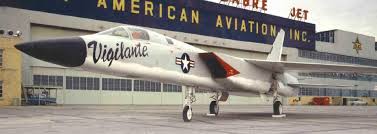✈️ North American A-5 Vigilante — Review
🧩 Overview
The A-5 Vigilante was a twin-engine, supersonic, carrier-based bomber designed for nuclear strike missions. Built by North American Aviation, it was introduced in the late 1950s with a sleek, futuristic look and bleeding-edge tech. Though it was later reassigned to the reconnaissance role as the RA-5C, it remains one of the fastest and most sophisticated aircraft to ever operate from an aircraft carrier.
⚙️ Specifications
-
First flight: August 31, 1958
-
Introduced: 1961
-
Retired: 1979 (RA-5C variant)
-
Crew: 2 (pilot and bombardier/navigator)
-
Length: 76 ft (23.2 m)
-
Wingspan: 53 ft (16.2 m)
-
Height: 19 ft (5.8 m)
-
Max speed: Mach 2.0 (~1,320 mph or 2,125 km/h)
-
Range: ~2,000 miles (3,200 km)
-
Engines: 2 × General Electric J79 turbojets
🛠 Design & Technology
-
Internal linear bomb bay: Instead of dropping bombs downward, the Vigilante ejected its nuclear weapon rearward using a special “linear bomb bay” — a unique and complex mechanism
-
Advanced avionics: First carrier aircraft to feature a fully integrated digital navigation and attack system
-
Sleek delta-like wings: Combined with tail-mounted horizontal stabilizers for stability at high speed
-
Variable geometry air intakes: Allowed better airflow control at supersonic speeds
-
RA-5C version: Carried sophisticated cameras, infrared sensors, ELINT gear, and side-looking radar
🧱 Strengths
-
Blazing speed for a carrier aircraft (Mach 2 capable)
-
Operated at high altitudes and long ranges
-
Excellent survivability thanks to speed and altitude
-
RA-5C version had one of the most comprehensive recon suites of the Vietnam War era
-
Proved the viability of high-speed reconnaissance over hostile territory
⚠️ Weaknesses
-
The nuclear strike version (A-5A/B) saw limited service — the Navy shifted its focus to submarine-based deterrence
-
Very complex and expensive to maintain
-
Had a high accident rate — partly due to its cutting-edge systems and carrier environment
-
Required large carriers (like the Forrestal class and beyond) to operate
🎯 Combat Use
-
The RA-5C variant flew hundreds of missions in Vietnam, providing real-time imagery and battlefield intelligence
-
Often flew deep over hostile territory, taking serious risks
-
Extremely valuable in target damage assessment and enemy movement tracking
-
Sadly, many RA-5Cs were lost to enemy fire or mechanical failure
🏁 Final Verdict
| Category | Rating (★ out of 5) |
|---|---|
| Performance | ★★★★★ |
| Reconnaissance Role | ★★★★★ |
| Combat Versatility | ★★☆☆☆ (Bomber) |
| Carrier Suitability | ★★★☆☆ |
| Legacy & Innovation | ★★★★★ |
🔚 Final Thoughts
The A-5 Vigilante was a bold leap into the future — fast, sleek, and high-tech. Though its role as a nuclear bomber was short-lived, its RA-5C reconnaissance variant became indispensable during Vietnam. It showed how speed, sensors, and stealth (pre-stealth tech) could shape modern air operations.
If the Vigilante was too far ahead of its time, it also paved the way for modern multi-role and recon jets — and remains a legend of carrier aviation.

Comments are closed